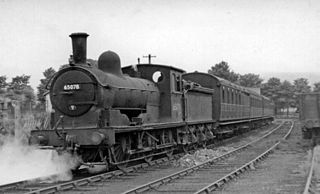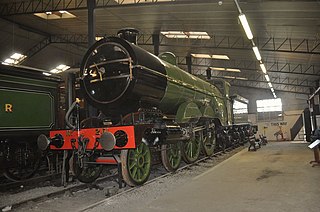A superheater is a device used to convert saturated steam or wet steam into superheated steam or dry steam. Superheated steam is used in steam turbines for electricity generation, steam engines, and in processes such as steam reforming. There are three types of superheaters: radiant, convection, and separately fired. A superheater can vary in size from a few tens of feet to several hundred feet.

The Caprotti valve gear is a type of steam engine valve gear invented in the early 1920s by Italian architect and engineer Arturo Caprotti. It uses camshafts and poppet valves rather than the piston valves used in other valve gear. While basing his design on automotive valves, Caprotti made several significant departures from this design to adapt the valves for steam. Having agreed a joint-venture with Worcester-based engineering company Heenan & Froude from 1938, Heenan & Froude fully acquired Caprotti post-World War II in 1947.

North Eastern Railway (NER) No. 66 Aerolite is a preserved British steam locomotive. It was classified X1 by the LNER. It was capable of reaching 55 mph.

The NBR C Class is a class of 0-6-0 steam locomotive designed by Matthew Holmes for freight work on the North British Railway. They were introduced in 1888 and had inside cylinders and Stephenson valve gear. A total of 168 locomotives was built, of which 123 came into British Railways ownership at nationalisation in 1948. This was the last class of steam engine in service in Scotland.

The North Eastern Railway (NER) Class C1, was a class of 0-6-0 freight locomotives designed by T.W. Worsdell. They were used throughout the NER system, although particularly in Teesside between 1886 and 1962.

The North Eastern Railway Class S3, classified B16 by the LNER, was a class of 4-6-0 steam locomotive designed for mixed traffic work. It was designed by Vincent Raven and introduced in 1920. The earlier members of this class were fitted with Westinghouse Brakes - all of this equipment was removed during the 1930s.

The Great Northern Railway (GNR) Class C1 is a type of 4-4-2 steam locomotive. One, ex GNR 251, later LNER 2800, survives in preservation. Much like their small boiler cousins, they were capable of reaching speeds of up to 90 mph. They were also known as Large Atlantics.

Thomas William Worsdell was an English locomotive engineer. He was born in Liverpool into a Quaker family.

The North Eastern Railway (NER) Class H, classified as Class Y7 by the London and North Eastern Railway (LNER) is a class of 0-4-0T steam locomotives designed for shunting.

The North Eastern Railway (NER) Class E, classified as Class J71 by the London and North Eastern Railway (LNER), was a class of small 0-6-0T steam locomotive designed by T.W. Worsdell. They had inside cylinders and Stephenson valve gear and were the basis for the later NER Class E1.

The North Eastern Railway (NER) Class Y 4-6-2T tank locomotives were designed whilst Wilson Worsdell was Chief Mechanical Engineer, but none were built until 1910 by which time Vincent Raven had taken over.
The NER Class 3CC was a 4-4-0 steam locomotive designed by Wilson Worsdell for the North Eastern Railway and built in 1893. Only one was built and it was a compound expansion version of the simple expansion NER Class M1. The 3CC was originally classified M but was re-classified 3CC in 1914, at the same time as the M1 was re-classified M.
A compound locomotive is a steam locomotive which is powered by a compound engine, a type of steam engine where steam is expanded in two or more stages. The locomotive was only one application of compounding. Two and three stages were used in ships, for example.

The North Eastern Railway Class S was a 4-6-0 type of steam locomotive designed for express passenger workings. The first example was built in 1899. They were very similar to the NER Class S1, except for the smaller wheels of the former.
The NER Class P was a class of 0-6-0 steam locomotives of the North Eastern Railway. They were designed by Wilson Worsdell for mineral traffic.
The NER Class L was a class of 0-6-0T steam locomotives of the North Eastern Railway. They were a specialised design, intended for use on the Redheugh and Quayside banks on either side of the River Tyne. They were replaced on the Quayside branch by NER Class ES1 electric locomotives in 1905 but were re-allocated to other duties.
The NER Class A was a class of 2-4-2 tank locomotives designed by Thomas William Worsdell and built at Gateshead works for the North Eastern Railway (NER). Sixty locomotives were built between 1886 and 1892. At this time the class was designated class A by the NER and was the first class in the company to be given an alphabetical letter classification.
The GCR Class 8C was a class of a pair of 4-6-0 locomotives built for the Great Central Railway in 1903–1904 by Beyer, Peacock and Company. They passed to the London and North Eastern Railway at the 1923 grouping and received the classification B1 They were reclassified B18 in 1943 and both were retired in 1947.
The NER Class F was a class of 4-4-0 steam locomotives of the North Eastern Railway. It was designed by Thomas William Worsdell and introduced in 1887.
The NER Class G was a class of 4-4-0 steam locomotives of the North Eastern Railway. It was designed by Thomas William Worsdell and introduced in 1887.











